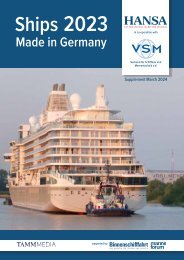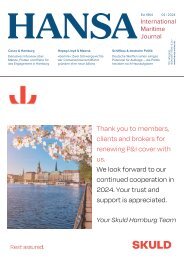HANSA 05-2017
Special Focus: NorShipping 2017 | HullPic Review | COMPIT Preview | Leonhardt & Blumberg | Sewol salvage | Tugs | German Banks | Tanker | Maritime Politics | Offshore Tender
Special Focus: NorShipping 2017 | HullPic Review | COMPIT Preview | Leonhardt & Blumberg | Sewol salvage | Tugs | German Banks | Tanker | Maritime Politics | Offshore Tender
Create successful ePaper yourself
Turn your PDF publications into a flip-book with our unique Google optimized e-Paper software.
Schiffstechnik | Ship Technology<br />
At recent HullPIC conference users and developers of hull performance<br />
monitoring software discussed how to include the future technology to do<br />
a more effective job. By Volker Bertram and Thomas Wägener<br />
Volker Bertram (DNV GL),<br />
co-organizer of the event, rates<br />
the conference as a success. The<br />
number of participants rose by 35%<br />
compared to the premiere event last<br />
year in Marorka, Italy, he says. At<br />
this year’s HullPIC in Ulrichshusen,<br />
Germany, about 110 international<br />
maritime experts from all over the<br />
world discussed how a ship’s hull<br />
can be further improved. »The high<br />
number of participants shows that<br />
the topics that we talked about are<br />
interesting for the maritime industry,«<br />
Bertram reasons.<br />
Many of the participants ccoming<br />
from about 20 different countries<br />
were from Scandinavia, but also<br />
from the Netherlands, Asia, Singapore<br />
and the USA. For nearly all of<br />
them the network character of the<br />
event was at least as important as the<br />
topics that were discussed. For Søren<br />
Hattel (Force Technology) it was interesting<br />
to see »that other companies<br />
have the same issues as us.« For<br />
Bjarte Lund (Kyma) it was also good<br />
to see »what the competitors are doing«.<br />
Furthermore he points out the<br />
great diversity of topics that were<br />
discussed at HullPIC.<br />
The conference ended with a forum<br />
discussion that had – somewhat<br />
cheekily – been given the title<br />
»Operators and Developers – Galaxies<br />
apart?« To make it short, the<br />
answer to this question appears to<br />
be »no«. On most points, the operator<br />
representatives (Rory Kennedy<br />
from cruise ship operator Royal Caribbean<br />
and Mike Servos from Tsakos<br />
Columbia Shipmanagement, operating<br />
oil tankers, bulkers and containerships)<br />
agreed with the developer<br />
representatives (Manolis Levantis<br />
of Jotun using a simulation-based<br />
approach and Matti Antola from<br />
Eniram using a machine-learning<br />
approach). Moderator Michael vom<br />
Baur (<strong>HANSA</strong>) tried to sound out<br />
differences using pointed remarks,<br />
but the panelists just wouldn’t bite<br />
– they remained true to the atmosphere<br />
of HullPIC where sober assessment<br />
of factual diffculties<br />
was the rule leaving little space for<br />
catch phrasing. Still, a clearer picture<br />
evolved and also the forum was<br />
unanimously seen as a success.<br />
The forum discussed first the key<br />
question that was on the mind of<br />
probably most of the HullPIC participants:<br />
Where are we with ISO<br />
19030? More specifically, vom Baur<br />
prodded the operators: In view of all<br />
the uncertainties presented at the<br />
conference (and there were many),<br />
how useful is performance monitoring?<br />
Mike Servos brought it to a<br />
point: »Five years ago we had nothing,<br />
now we have at least something.«<br />
Rory Kennedy agreed, taking a positive<br />
angle on the state of the standard<br />
and performance monitoring in<br />
the industry. RCCL has started with<br />
performance monitoring some years<br />
ago and made already some impressive<br />
progress with double-digit savings.<br />
It is a process that will continue,<br />
both on the development and on the<br />
implementation. So – surprise – the<br />
users think better than the developers<br />
and the maritime world in general<br />
would have thought.<br />
Is machine learning the way forward<br />
or is it simulation? Perhaps it<br />
was gentlemen behavior, perhaps<br />
simple realization of the intricacies of<br />
performance monitoring: The developers<br />
of the more simulation-based<br />
approach recalled the importance of<br />
calibrating models against in-service<br />
experience and the developers<br />
of the more machine-learning based<br />
approach mentioned the usefulness<br />
of virtual sensors and good hydrodynamic<br />
models. As in HullPIC 2016,<br />
the maritime industry was once<br />
more reminded that all systems on<br />
the market are »grey«, using hydrodynamic<br />
modelling with some system<br />
identification.<br />
The discussion then turned towards<br />
a theme that had woven like a red<br />
thread through the conference: sensors,<br />
human input and how we can<br />
reduce errors in the input data for<br />
performance monitoring. »With all<br />
the discussions about speed logs,<br />
torque meters, ambient conditions,<br />
etc. – should we focus on getting<br />
black boxes or should we focus on<br />
the ›human factor‹?« And touching<br />
on autonomous technology, should<br />
machines do the job (of collecting<br />
and monitoring) or humans?<br />
On this point, all panelists and<br />
quite a few members of the audience<br />
commented, but the positions were<br />
surprisingly close again. The consensus<br />
was that it was not a question of<br />
»either – or«, but »both« played a vital<br />
role. All operators agreed that having<br />
transparent and timely feedback<br />
to the crew improved motivation and<br />
data quality. But data frequency and<br />
good algorithms are important, too.<br />
Daniel Schmode (DNV GL) expanded<br />
on the theme of his paper on how<br />
to reduce errors in performance monitoring:<br />
The crew is key to get bias<br />
(= systematic errors) down; data frequency<br />
is key to get noise (= random<br />
errors and scatter) down. In the end,<br />
you need both for good performance<br />
monitoring.<br />
For this point, the discussion went<br />
naturally to »Big Data«. It is coming,<br />
but as such nobody seemed to be overly<br />
impressed. »A lot of data still does<br />
not equal a lot of insight« received a<br />
lot of agreeing nods both from the operators<br />
and the developers. But using<br />
smart filters to automatically identify<br />
wrong data was seen as a likely way<br />
performance monitoring will evolve.<br />
Information fusion combining various<br />
sensors, on-line services (e.g. for<br />
weather conditions or AIS speed and<br />
course data) and human data reporting<br />
is on horizon.<br />
In summary, the forum discussion<br />
took a rather positive view of the ISO<br />
19030 and the state of performance<br />
monitoring. Both the standard and<br />
the implementation in the industry<br />
are deemed to be work in progress.<br />
The way forward is cooperative sharing<br />
of experience.<br />
M<br />
Photo: Jotun<br />
<strong>HANSA</strong> International Maritime Journal – 154. Jahrgang – <strong>2017</strong> – Nr. 5 77


















